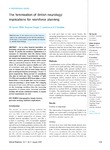The feminisation of British neurology: implications for workforce planning
| dc.contributor.author | Carroll, Camille | |
| dc.contributor.author | Tengah, DSNAP | |
| dc.contributor.author | Lawthom, C | |
| dc.contributor.author | Venables, G | |
| dc.date.accessioned | 2015-07-29T12:31:37Z | |
| dc.date.available | 2015-07-29T12:31:37Z | |
| dc.date.issued | 2007-08-01 | |
| dc.identifier.issn | 1470-2118 | |
| dc.identifier.issn | 1473-4893 | |
| dc.identifier.uri | http://hdl.handle.net/10026.1/3491 | |
| dc.description.abstract |
As in other hospital specialties, an increasing proportion of neurology trainees are female. To predict the workforce implications it is necessary to determine what life choices future neurologists will make. A questionnaire survey of life choices was administered to neurology consultants and trainees, general medical senior house officers, and medical students. Of the 344 respondents, 3% of specialist registrars (SpRs) and 4.6% of consultants work part time. Eighty-seven per cent of female and 22% of male junior doctors plan to work part time for, on average, 7.5 and 1.5 years respectively. Thirty percent of consultants also plan to work part time. A number of SpRs (14.3%) and consultants (6%) have taken a career break while 37.5% of SpRs and 18.2% of consultants are planning a career break. The changing demands of both sexes will have a greater impact on the neurology workforce than the increasing proportion of women alone. Increased part-time working will require additional trainees to ensure service requirements are met. | |
| dc.format.extent | 339-342 | |
| dc.format.medium | ||
| dc.language | en | |
| dc.language.iso | eng | |
| dc.publisher | Royal College of Physicians | |
| dc.subject | demographics | |
| dc.subject | female doctors | |
| dc.subject | part-time working | |
| dc.subject | workforce implications | |
| dc.title | The feminisation of British neurology: implications for workforce planning | |
| dc.type | journal-article | |
| dc.type | Journal Article | |
| plymouth.author-url | https://www.webofscience.com/api/gateway?GWVersion=2&SrcApp=PARTNER_APP&SrcAuth=LinksAMR&KeyUT=WOS:000248838700010&DestLinkType=FullRecord&DestApp=ALL_WOS&UsrCustomerID=11bb513d99f797142bcfeffcc58ea008 | |
| plymouth.issue | 4 | |
| plymouth.volume | 7 | |
| plymouth.publication-status | Published | |
| plymouth.journal | Clinical Medicine | |
| dc.identifier.doi | 10.7861/clinmedicine.7-4-339 | |
| plymouth.organisational-group | /Plymouth | |
| plymouth.organisational-group | /Plymouth/Faculty of Health | |
| plymouth.organisational-group | /Plymouth/REF 2021 Researchers by UoA | |
| plymouth.organisational-group | /Plymouth/REF 2021 Researchers by UoA/UoA03 Allied Health Professions, Dentistry, Nursing and Pharmacy | |
| plymouth.organisational-group | /Plymouth/Research Groups | |
| plymouth.organisational-group | /Plymouth/Research Groups/FoH - Applied Parkinson's Research | |
| plymouth.organisational-group | /Plymouth/Research Groups/FoH - Community and Primary Care | |
| plymouth.organisational-group | /Plymouth/Research Groups/Institute of Translational and Stratified Medicine (ITSMED) | |
| plymouth.organisational-group | /Plymouth/Research Groups/Institute of Translational and Stratified Medicine (ITSMED)/CCT&PS | |
| plymouth.organisational-group | /Plymouth/Users by role | |
| plymouth.organisational-group | /Plymouth/Users by role/Academics | |
| dc.publisher.place | England | |
| dc.identifier.eissn | 1473-4893 | |
| dc.rights.embargoperiod | Not known | |
| rioxxterms.versionofrecord | 10.7861/clinmedicine.7-4-339 | |
| rioxxterms.licenseref.uri | http://www.rioxx.net/licenses/all-rights-reserved | |
| rioxxterms.type | Journal Article/Review |


